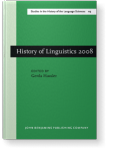Z. S. Harris and the semantic turn of mathematical information theory
This paper aims at presenting Harris’ use of information theory as a specific case of transfer of mathematical concepts and methods into linguistics. First, it will show that distributional analysis had characteristics which made it particularly receptive to some aspects of information theory, such as the special status of repetition and the treatment of linguistic elements as physical events. Second, this paper will show how Harris gradually incorporated the notions of information theory and methods to address new issues in his own theory: from the identification and classification of linguistic units to the analysis of redundant patterns in utterances and in discourses, and finally to the ultimate objective of developing an information grammar for the sublanguages of sciences. Thus, information, at first a pure quantitative entity, underwent a semantic turn when Harris adapted it for linguistic objectives.
